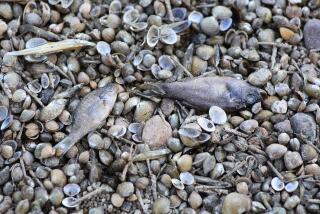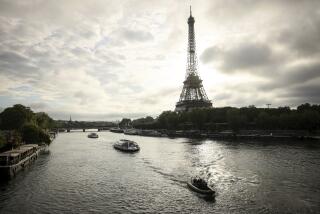Floods Bring Relief to Friends of Elbe River
DESSAU, Germany — It came from the heavens with thunder and lightning and a deluge of biblical proportions.
Much as one would imagine a miracle, the rescue of the Elbe River--which had been creeping along for a decade--culminated this summer when the skies opened and washed away deeply unpopular plans to dredge the central stretch of the waterway for shipping.
Just a month before the deluge, Germans reveled in the Elbe’s newfound purity with a mass “Bathing Day” along its 700-mile length. They rejoiced that the river, which for centuries had been celebrated in art, history and literature, had recovered from the reckless industrial development of the Communist era. And they railed against the dredging plan, whose proponents sought relief from overwhelmed freight trains and truck-clogged highways.
Then came the torrential rains, wiping out billions in property and killing at least 20 people. Environmentalists and scientists are blaming the flood on global warming from harmful gases released by automobiles, airplanes and industry. Suddenly, long-ignored warnings are being heeded that messing with the natural order of things can lead to destruction.
“The political lobby pushing to dredge the river has completely fallen apart since the floods,” says Ernst Paul Doerfler, a writer who has spearheaded an Elbe cleanup mission for the last decade for the Assn. for Environment and Nature Protection. “Even the chancellor has recently come out against the project.”
Now the regional development priority is on projects more in harmony with nature.
“The Elbe is the last free-flowing major river left in Europe,” says Foreign Minister Joschka Fischer of the environmentalist Greens party. “It doesn’t even make economic sense to dredge it, and I’m sure after this catastrophe that the project will be reconsidered.”
Until recently, the waterway that once provided a backdrop for Johann Wolfgang von Goethe and the Brothers Grimm was so befouled that it could poison a person’s blood. Quicksilver from chemical plants in Bitterfeld and paper-mill effluent from Dresden had made their way to the mainstream, slowly choking to death millennium-old oaks with the byproducts of hell-bent industrialization.
“There was so much lead in the soil from industrial waste that we had to remove the surviving animals from the [game preserve] to prevent their dying from lead poisoning,” horticulturist Ludwig Trauzettel recalls. “And people couldn’t sit on the grass. It was so infused with chemical waste, it had to be disposed of in sealed containers.”
But Europe’s filthiest river has proven extraordinarily forgiving. As the factories and energy plants that had powered the East German economy shut down after Germany’s 1990 reunification, they took their poisonous effluents and workplaces with them.
Gone, almost overnight, were the oil refineries, the coal-fired electricity plants, the smoke-belching steel factories and the pesticide-spewing farm machinery that had been dumping waste water into the river throughout the rapid industrial buildup that followed World War II.
West German industries also played a part in the Elbe’s 20th century pollution. At the river’s broad outlet into the North Sea, at Cuxhaven, biologist Heinrich Reincke has been monitoring the river’s flow and water quality for the last two decades. He notes, as a nearby example, the massive Dow Chemical plant in Stade that was dumping toxins at the rate of 12 tons a day in 1980. Subsequent changes in environmental regulation and technology improvements have reduced that to less than 440 pounds daily, he says.
Along the length of the Elbe, industrial cleanup and shutdown led to a virtual halt in the dumping of heavy metals. The construction of better sewers and drainage cut nutrient waste by 70%.
The most telling of the Elbe’s recent turning points, though, was the river-long “baptism” held July 14, in which thousands of swimmers gleefully waded into the waters from the sandy shores and city piers along the river. The mass bathing event is expected to be an annual activity.
One of the few surviving stretches of river in Central Europe spared the concrete flanking and locks built to facilitate shipping, the Elbe is a scene of bucolic serenity as it flows lazily from the urban centers of Dresden and Magdeburg. Dessau and other smaller riverfront cities along the Mittlere Elbe, or Middle Elbe, nurtured hopes after the cleanup of returning to the tree-shaded banks and reedy estuaries that their grandparents fondly remembered as weekend idylls.
Those dreams seemed shattered amid the roaring, churned-up torrent that swept through the central reaches in mid-August. But scientists such as Reincke say the damage will be short-lived. In fact, the muck-covered towpaths and riverside trails are now mostly clear again as the sun returned after the deluge.
Locals say the region’s most attractive sights are dependent on a clean Elbe--a point the dredging enthusiasts now seem unwilling to counter.
The Woerlitzer Park Garden Kingdom, for instance, draws a million visitors a year to the idyllic inlets, lakes and channels and the dappling emerald fields and woodlands a few miles east of Dessau. Farther upriver is another popular tourist attraction, the town of Wittenberg, where Martin Luther nailed his famous theses on the Castle Church door in 1517.
To the south, plaques and historical exhibits mark the riverside spot near Torgau where Soviet and U.S. soldiers met up after four years of fighting Nazi forces. Thanks to the massive turnout of volunteers to sandbag those Elbe landmarks, the region’s key tourist sites survived the flood with minimal damage.
Roswitha Heilmann, manager of the Kornhaus restaurant that dates to the 1920s heyday of Bauhaus architecture, says the improvement in the water quality is having an agreeable effect on patronage at her riverside establishment.
“On nice days, the storks gather on the sand spits across the water and boaters and cyclists have returned to the shores,” she says, casting an approving eye over the serene landscape of humanity communing with nature.
The floods did take an enormous toll on the Elbe.
Biologist Reincke says the storms flushed the effluent in storm drains, sewage treatment plants and storage basins into the river, filling it with fresh nutrient waste and oily scum. But the damage was far below the levels of industrial dumping of the Communist era, sparing the newly recovered Elbe from serious long-term damage, he says.
“It’s a horrible, tragic setback after such a positive development,” Reincke says of the flood damage. “But the river will recover completely in one to two years.”
Scientists are pleased that the massive fish kills they feared haven’t materialized. Little risk of toxic concentrations is expected because the fish were exposed to contaminants for only a few days during the height of the flooding.
How quickly the Elbe can refresh its flow with clean water depends in part on the cleanup behavior of upstream residents in the Czech Republic. But Reincke notes that the Czechs have been diligent in their efforts to improve environmental protection as they struggle to qualify for European Union membership.
Before the flooding, the improved water quality had allowed salmon to be reintroduced to the river, while most other fish that had been killed off by pollution returned on their own. The fish are still plying the Elbe, but health officials have warned anglers to refrain from eating their catch for a few months so that new tests can be conducted on suitability for consumption.
With the waters now murky from the soil, debris and sewage swept up by the flood, swimming has yet to resume even amid a belated heat wave after a wet summer. But neither has the dredging and damming of the river, and few expect it to win renewed endorsement.
The dredging project had been on hold before the flood because of mounting local opposition, and those lobbying against the work see the inundation as a death blow to the plan.
Deepening the channel by a few inches made little sense before the disaster, and now German and European development funds will be needed for more pressing projects to rebuild what the flood destroyed, says Iris Brunar, spokeswoman for the Pro Elbe local citizens initiative.
Among the dredging project’s most powerful opponents are the Lutheran Church members in Saxony-Anhalt state, who before the flood had resumed using the river for baptisms for the first time in decades.
“We are in principle against anything that pollutes the environment. This is all God’s creation, and we are just a part of it,” district church spokeswoman Karin Bertheau says of humanity’s responsibility to its surroundings. She echoes the environmentalists’ view that there is too little demand for river freight capacity to justify deepening the channel.
At Woerlitzer, an 18th century estate whose English gardens are sculpted around Elbe backwaters, horticulturist Trauzettel totes up the pluses and minuses of the natural disaster and concludes that the floods probably spared the retreat the worse fate that would have resulted from dredging. The deeper the river runs, he says, the more water it will drain from the regional table, leaving trees, crops and shrubbery to die from dehydration.
“We’ve already ruined the ecology of much of this region from the heavy industry that dominated after the war,” says Trauzettel, who is responsible for preserving the lush park, which spreads across nearly 70 square miles and has been designated a UNESCO World Heritage site.
That the Elbe came back to life in a mere decade “is a tribute to the river’s resilience and a second chance for the community to find a more harmonious balance” with its natural surroundings, Trauzettel says.
“The biggest problem is the threat to the ground water level and what this could do to agriculture and forestry in the area,” adds Guido Puhlmann, a conservationist at the nearby Mittlere Elbe Biosphere Reserve.
Noting that it takes decades to show the damage to ground water levels from dredging and flanking a river, he concedes that there were too few statistics or scientific arguments against dredging before the inundation.
Now, say those who have long fought for the river’s natural freedom, Mother Nature has spoken.
More to Read
Sign up for Essential California
The most important California stories and recommendations in your inbox every morning.
You may occasionally receive promotional content from the Los Angeles Times.










